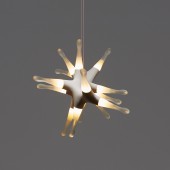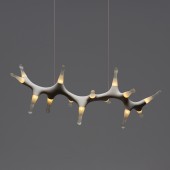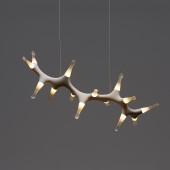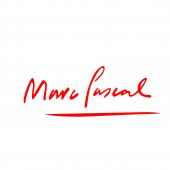Leefy See Dragon Pendant Light by Marc Pascal |
Home > Winners > #49128 |
 |
|
||||
| DESIGN DETAILS | |||||
| DESIGN NAME: Leefy See Dragon PRIMARY FUNCTION: Pendant Light INSPIRATION: The leafy sea dragon is an ocean creature unique to the waters of South Eastern Australia, and is the inspiration for this light. This curious animal mates for life, with the father carrying the eggs until they hatch. The form of this light reflect the poetry of this rare sea creature as it uses the ocean currents to glide along seaweed forests, cleverly disguising itself with its sea-weed like frills. Even with its ornate and decorated form, this creature holds itself with a quiet dignity. How long can it survive in this changing world? I am happy with my designs only when I find them deeply pleasing myself, in this way, I am my own client first. I wanted to create a pendant with many branches of light, reaching in all directions, playful and sensuous, like the leafy sea dragon. I was lucky enough to watch a leafy sea dragon in its natural environment, whilst snorkeling, just an hour or so from Melbourne. This lucky encounter fueled my inspiration to finish this project through all the technical difficulties I encountered. Developing this light required a lot of patience. UNIQUE PROPERTIES / PROJECT DESCRIPTION: This light is a study of the organic and sensuous. A departure from my previous range of lighting, it is also a return to my design roots, and uses techniques that I have developed over years of practice. The compound organic form is sophisticated, yet simple, echoing the lines of the ceramic forms that I designed earlier in my career. The result is a luminaire that quintessentially reflects my unique design style. OPERATION / FLOW / INTERACTION: The Leefy See Dragon makes a dramatic focus point in any space with its dynamic form. The sculptural aspect of the light make it appealing in both lit and unlit state. This light can be mounted in a horizontal or vertical format, the horizontal giving many options as each of the two suspension points are adjustable, one can play with the angles to create a dynamic composition. The body can be coloured by carefully mixing pigments which are added to the Forton, this gives a very sensuous, smooth and satin finish, and the nodes can be removed and changed as new node shapes are developed, giving the client many options for their made-to-order light. PROJECT DURATION AND LOCATION: This project is finishing now June 2016, but began in 2012. It has been developed and made in my studio in Melbourne, Australia, and was first exhibited here in Melbourne. However, it is an ongoing project, as different node shapes will be developed for the light. FITS BEST INTO CATEGORY: Lighting Products and Fixtures Design |
PRODUCTION / REALIZATION TECHNOLOGY: Design began with wooden models, which informed the computer models made in Rhino and T-Splines. The pattern was 3D printed in sections, and a two-piece silicon mould was made with 14 inserts for the globe holders. Wiring is concealed within the form, and positive and negative wires exit the top of the mould. The body is rotationally moulded in Forton and infilled with urethane foam for strength and lightness. The nodes were created in Rhino and the pattern 3D printed to create more moulds. SPECIFICATIONS / TECHNICAL PROPERTIES: Length 1105mm x Width 430 x Height 430mm Body materials: Forton, pigment, hardener, chopped strand, urethane foam, 12 volt LED's x 14 -G4-2W with LED driver in the ceiling, or 240 &110 Volt LED's x 14 -G9-2W. package dimensions: 100 x 20 x 230cm @ 4kg The body of the light contains the wiring and the 14 lamp holders, the optically clear urethane nodes are a interference fit, allowing the globes to be changed and making the light rainproof. The body and nodes are cast from moulds, in my Melbourne studio The light is suspended from the ceiling by by two teflon coated wires that power the light The ceiling canopy is made from Forton. The light is made to order in any colour. TAGS: leefy, see, dragon, leafy, sea, pendant, light, LED, Marc, Pascal RESEARCH ABSTRACT: Mould making and casting are the techniques used in making this light. A fusion of traditional and digital pattern making techniques were used. The electric components of the light are concealed within the form. Specific techniques and materials used were refined through experimentation. Each material required specific techniques such as rotational moulding. This project elevated my patternamaking, mould making and casting techniques, enabling new future design possiblities. CHALLENGE: Working within the computer on a surface form is not the same as touching a real object, once the pattern had been printed and I could hold it, I realized I needed to add and subtract from the from. Another problem I needed to overcome was the casting of the main body, it needed to be light weight and strong, a solid was way too heavy. The solution was to rotational mould Forton twice, and then fill the void with urethane, the sprue is then concealed. The result is light weight and strong. ADDED DATE: 2016-06-24 15:31:24 TEAM MEMBERS (1) : Designer: Marc Pascal IMAGE CREDITS: Chris Kapa |
||||
| Visit the following page to learn more: http://www.marcpascal.com | |||||
| AWARD DETAILS | |
 |
Leefy See Dragon Pendant Light by Marc Pascal is Winner in Lighting Products and Fixtures Design Category, 2016 - 2017.· Read the interview with designer Marc Pascal for design Leefy See Dragon here.· Press Members: Login or Register to request an exclusive interview with Marc Pascal . · Click here to register inorder to view the profile and other works by Marc Pascal . |
| SOCIAL |
| + Add to Likes / Favorites | Send to My Email | Comment | Testimonials | View Press-Release | Press Kit |
Did you like Marc Pascal's Lighting Design?
You will most likely enjoy other award winning lighting design as well.
Click here to view more Award Winning Lighting Design.








